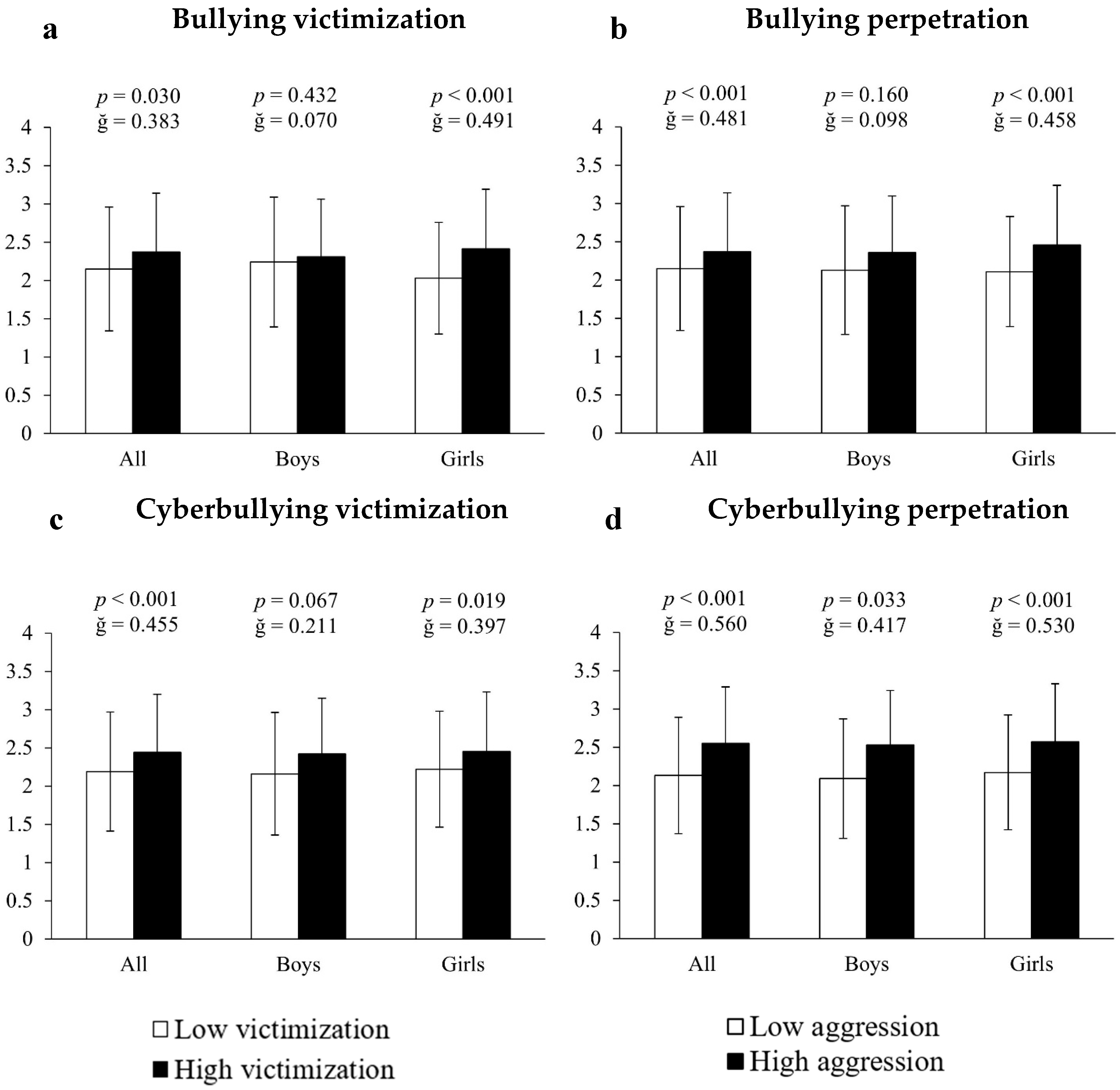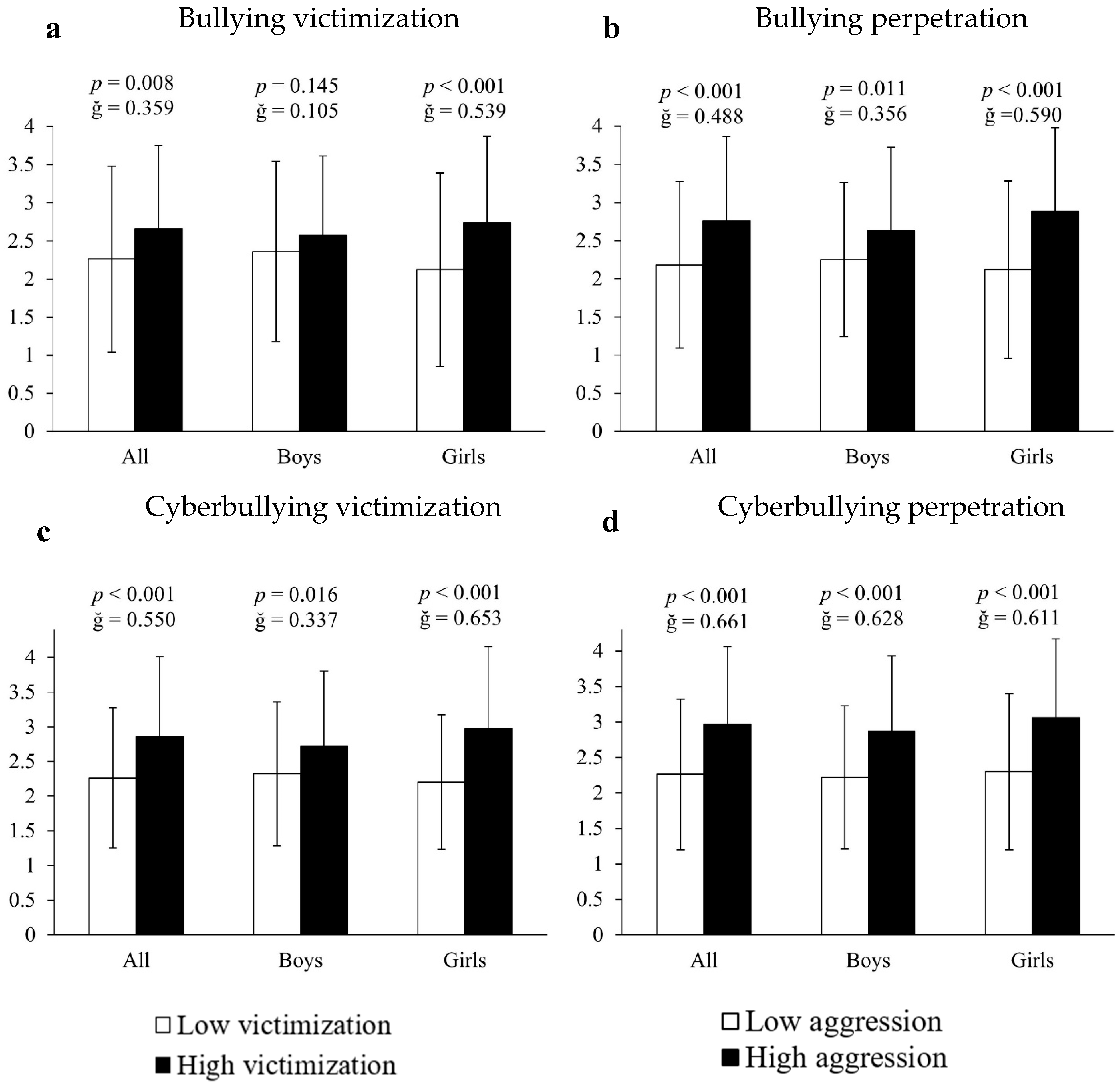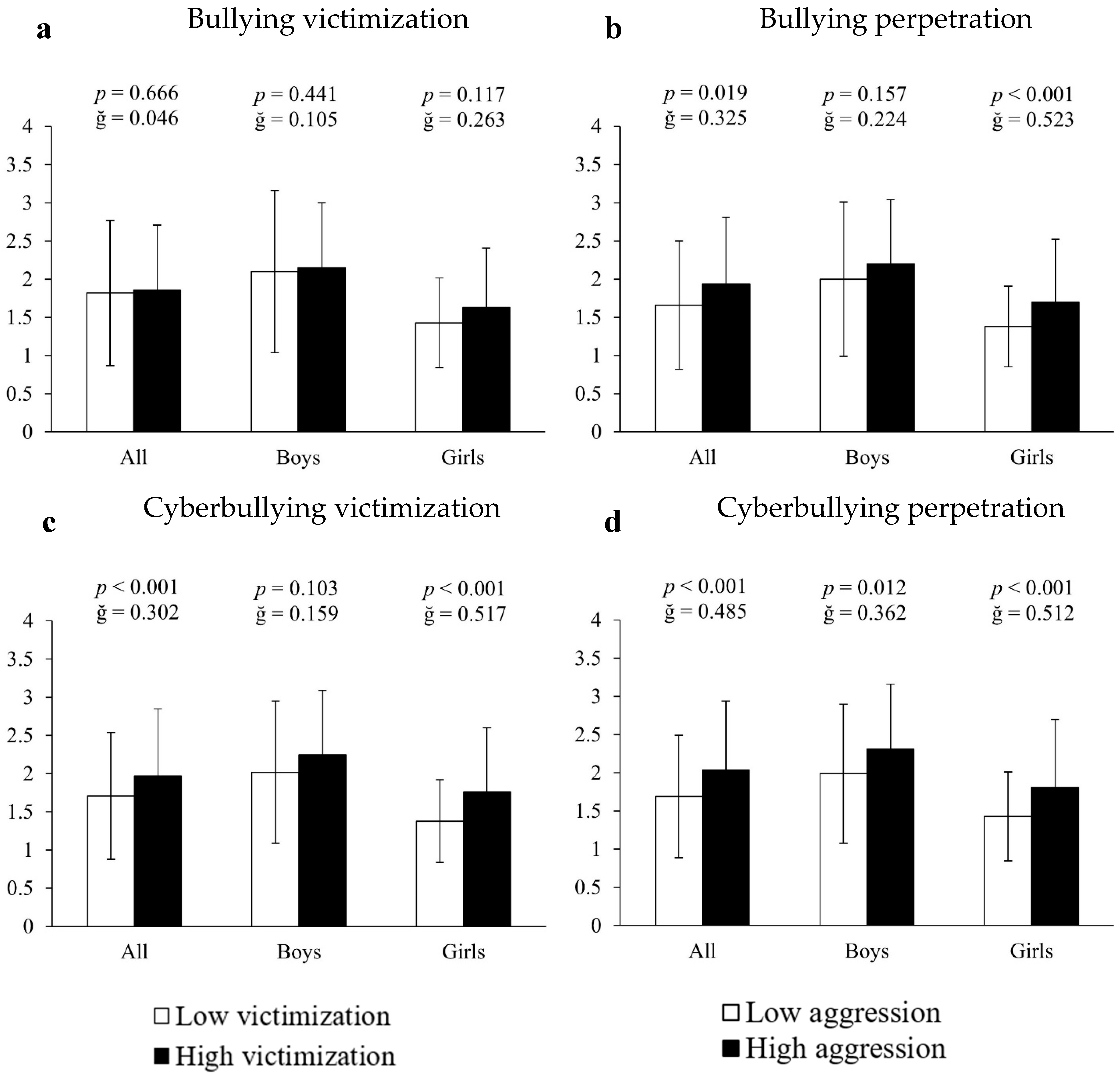Correction: Moral-García et al. (2025). Bullying and Cyberbullying Are Associated with Inappropriate Use of the Internet, Cell Phones, and Video Games in Children and Adolescents. European Journal of Investigation in Health, Psychology and Education, 15(5), 82
Reference
- Moral-García, J. E., Rusillo-Magdaleno, A., Patiño-Villada, F. A., & Martínez-López, E. J. (2025). Bullying and cyberbullying are associated with inappropriate use of the internet, cell phones, and video games in children and adolescents. European Journal of Investigation in Health, Psychology and Education, 15(5), 82. [Google Scholar] [CrossRef] [PubMed]



| All (677) | Boys (318) | Girls (359) | |||||||||||
|---|---|---|---|---|---|---|---|---|---|---|---|---|---|
| N | p | OR | 95%IC | N | p | OR | 95%IC | N | p | OR | 95%IC | ||
| Bullying victimization | |||||||||||||
| Internet | Low | 326 | 1 | Referent | 151 | 1 | Referent | 175 | 1 | Referent | |||
| High | 341 | <0.001 | 1.606 | 1.286–2.005 | 159 | 0.080 | 1.313 | 0.968–1.780 | 182 | <0.001 | 2.080 | 1.489–2.906 | |
| Mobile phone | Low | 334 | 1 | Referent | 169 | 1 | Referent | 165 | Referent | ||||
| High | 333 | <0.001 | 2.017 | 1.597–2.548 | 141 | 0.098 | 1.513 | 1.114–2.054 | 192 | <0.001 | 2.898 | 2.000–4.199 | |
| Videogames | Low | 344 | 1 | Referent | 110 | 1 | Referent | 234 | Referent | ||||
| High | 323 | 0.313 | 1.114 | 0.901–1.621 | 200 | 0.629 | 1.001 | 0.911–1.898 | 123 | <0.001 | 1.767 | 1.291–2.419 | |
| Bullying perpetration | |||||||||||||
| Internet | Low | 326 | 1 | Referent | 151 | 1 | Referent | 175 | 1 | Referent | |||
| High | 341 | <0.001 | 2.116 | 1.576–2.841 | 159 | 0.027 | 1.503 | 1.047–2.157 | 182 | <0.001 | 3.826 | 2.268–6.453 | |
| Mobile phone | Low | 334 | 1 | Referent | 169 | 1 | Referent | 165 | 1 | Referent | |||
| High | 333 | <0.001 | 2.521 | 1.850–3.436 | 141 | 0.006 | 1.659 | 1.158–2.375 | 192 | <0.001 | 8.068 | 4.051–16.067 | |
| Videogames | Low | 344 | 1 | Referent | 110 | 1 | Referent | 234 | 1 | Referent | |||
| High | 323 | <0.001 | 3.002 | 2.162–4.168 | 200 | 0.208 | 1.181 | 0.901–2.407 | 123 | <0.001 | 3.403 | 2.096–5.526 | |
| Cyberbullying victimization | |||||||||||||
| Internet | Low | 326 | 1 | Referent | 151 | 1 | Referent | 175 | Referent | ||||
| High | 341 | <0.001 | 4.531 | 2.804–7.322 | 159 | 0.006 | 3.279 | 1.650–6.514 | 182 | <0.001 | 5.998 | 3.061–11.752 | |
| Mobile phone | Low | 334 | 1 | Referent | 169 | 1 | Referent | 165 | Referent | ||||
| High | 333 | <0.001 | 7.980 | 4.477–14.222 | 141 | <0.001 | 4.585 | 2.223–9.455 | 192 | <0.001 | 16.473 | 5.940–45.686 | |
| Videogames | Low | 344 | 1 | Referent | 110 | 1 | Referent | 234 | Referent | ||||
| High | 323 | <0.001 | 4.616 | 2.809–7.583 | 200 | 0.049 | 3.999 | 1.009–12.732 | 123 | <0.001 | 5.484 | 2.967–10.137 | |
| Cyberbullying perpetration | |||||||||||||
| Internet | Low | 326 | 1 | Referent | 151 | 1 | Referent | 175 | 1 | Referent | |||
| High | 341 | <0.001 | 5.782 | 3.198–10.455 | 159 | 0.019 | 4.137 | 1.944–8.803 | 182 | <0.001 | 8.628 | 3.282–22.683 | |
| Mobile phone | Low | 334 | 1 | Referent | 169 | 1 | Referent | 165 | 1 | Referent | |||
| High | 333 | <0.001 | 14.367 | 6.358–32.465 | 141 | <0.001 | 8.394 | 3.377–20.862 | 192 | <0.001 | 14.333 | 4.554–38.113 | |
| Videogames | Low | 344 | 1 | Referent | 110 | 1 | Referent | 234 | 1 | Referent | |||
| High | 323 | <0.001 | 3.839 | 3.562–13.132 | 200 | <0.001 | 5.091 | 1.926–13.459 | 123 | <0.001 | 9.699 | 3.676–25.589 | |
Disclaimer/Publisher’s Note: The statements, opinions and data contained in all publications are solely those of the individual author(s) and contributor(s) and not of MDPI and/or the editor(s). MDPI and/or the editor(s) disclaim responsibility for any injury to people or property resulting from any ideas, methods, instructions or products referred to in the content. |
© 2025 by the authors. Published by MDPI on behalf of the University Association of Education and Psychology. Licensee MDPI, Basel, Switzerland. This article is an open access article distributed under the terms and conditions of the Creative Commons Attribution (CC BY) license (https://creativecommons.org/licenses/by/4.0/).
Share and Cite
Moral-García, J.E.; Rusillo-Magdaleno, A.; Patiño-Villada, F.A.; Martínez-López, E.J. Correction: Moral-García et al. (2025). Bullying and Cyberbullying Are Associated with Inappropriate Use of the Internet, Cell Phones, and Video Games in Children and Adolescents. European Journal of Investigation in Health, Psychology and Education, 15(5), 82. Eur. J. Investig. Health Psychol. Educ. 2025, 15, 108. https://doi.org/10.3390/ejihpe15060108
Moral-García JE, Rusillo-Magdaleno A, Patiño-Villada FA, Martínez-López EJ. Correction: Moral-García et al. (2025). Bullying and Cyberbullying Are Associated with Inappropriate Use of the Internet, Cell Phones, and Video Games in Children and Adolescents. European Journal of Investigation in Health, Psychology and Education, 15(5), 82. European Journal of Investigation in Health, Psychology and Education. 2025; 15(6):108. https://doi.org/10.3390/ejihpe15060108
Chicago/Turabian StyleMoral-García, José Enrique, Alba Rusillo-Magdaleno, Fredy Alonso Patiño-Villada, and Emilio J. Martínez-López. 2025. "Correction: Moral-García et al. (2025). Bullying and Cyberbullying Are Associated with Inappropriate Use of the Internet, Cell Phones, and Video Games in Children and Adolescents. European Journal of Investigation in Health, Psychology and Education, 15(5), 82" European Journal of Investigation in Health, Psychology and Education 15, no. 6: 108. https://doi.org/10.3390/ejihpe15060108
APA StyleMoral-García, J. E., Rusillo-Magdaleno, A., Patiño-Villada, F. A., & Martínez-López, E. J. (2025). Correction: Moral-García et al. (2025). Bullying and Cyberbullying Are Associated with Inappropriate Use of the Internet, Cell Phones, and Video Games in Children and Adolescents. European Journal of Investigation in Health, Psychology and Education, 15(5), 82. European Journal of Investigation in Health, Psychology and Education, 15(6), 108. https://doi.org/10.3390/ejihpe15060108





